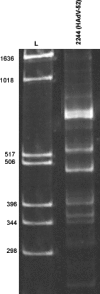New adenovirus species found in a patient presenting with gastroenteritis
- PMID: 17360747
- PMCID: PMC1900323
- DOI: 10.1128/JVI.02650-06
New adenovirus species found in a patient presenting with gastroenteritis
Abstract
An unidentified agent was cultured in primary monkey cells at the Los Angeles County Public Health Department from each of five stool specimens submitted from an outbreak of gastroenteritis. Electron microscopy and an adenovirus-specific monoclonal antibody confirmed this agent to be an adenovirus. Since viral titers were too low, complete serotyping was not possible. Using the DNase-sequence-independent viral nucleic acid amplification method, we identified several nucleotide sequences with a high homology to human adenovirus 41 (HAdV-41) and simian adenovirus 1 (SAdV-1). However, using anti-SAdV-1 sera, it was determined that this virus was serologically different than SAdV-1. Genomic sequencing and phylogenetic analysis confirmed that this new adenovirus was so divergent from the known human adenoviruses that it was not only a new type but also represented a new species (human adenovirus G). In a retrospective clinical study, this new virus was detected by PCR in one additional patient from a separate gastroenteritis outbreak. This study suggests that HAdV-52 may be one of many agents causing gastroenteritis of unknown etiology.
Figures





Comment in
-
Human adenovirus type 52: a type 41 in disguise?J Virol. 2008 Apr;82(7):3809; author reply 3809-10. doi: 10.1128/JVI.02457-07. J Virol. 2008. PMID: 18334604 Free PMC article. No abstract available.
References
-
- Albinsson, B., and A. H. Kidd. 1999. Adenovirus type 41 lacks an RGD αv-integrin binding motif on the penton base and undergoes delayed uptake in A549 cells. Virus Res. 64:125-136. - PubMed
-
- Bailey, A., and V. Mautner. 1994. Phylogenetic relationships among adenovirus serotypes. Virology 205:438-452. - PubMed
-
- Benkö, M., and B. Harrach. 2003. Molecular evolution of adenoviruses. Curr. Top. Microbiol. Immunol. 272:3-35. - PubMed
-
- Benkö, M., B. Harrach, G. W. Both, W. C. Russell, B. M. Adair, E. Adam, J. C. de Jong, M. Hess, M. Johnson, A. Kajon, A. H. Kidd, H. D. Lehmkuhl, Q.-G. Li, V. Mautner, P. Pring-Akerblom, and G. Wadell. 2005. Family Adenoviridae, p. 213-228. In C. M. Fauquet, M. A. Mayo, J. Maniloff, U. Desselberger, and L. A. Ball (ed.), Virus taxonomy. VIIIth Report of the International Committee on Taxonomy of Viruses. Elsevier, New York, NY.
Publication types
MeSH terms
Associated data
- Actions
LinkOut - more resources
Full Text Sources
Medical

